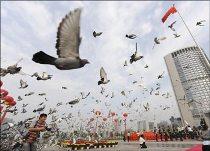 | « Back to article | Print this article |
Asia paves way for global recovery
As the world climbs out of the deepest recession in recent history, Asia is leading the global recovery.
 By end-2009, output and exports had returned to pre-crisis levels in most of Asia, including the hardest-hit economies.
By end-2009, output and exports had returned to pre-crisis levels in most of Asia, including the hardest-hit economies.
In our recently-released Asia-Pacific Regional Economic Outlook, we envisage that, on average, Asia will grow by 7 per cent this year and next, buoyed by growth in China, India and other countries.
While activity in advanced countries remains held back by high unemployment and weak household and bank balance sheets, in Asia the picture is relatively more robust.
In the near term, we expect that Asia will continue to lead the global recovery. What underlies this robust growth picture?
While public stimulus is being phased out in some countries, growth should be sustained by the momentum that has developed in private domestic demand.
Private consumption is growing on the basis of high asset values, growing consumer confidence and good labour market prospects, and private investment is being boosted by increases in capacity utilisation to more normal levels.
In addition, the recovery of demand in advanced economies, particularly the United States, is expected to continue fuelling a re-stocking of inventories through most of 2010 that will boost Asian production and exports.
At the same time, the fragile nature of the global recovery still poses a risk for Asia. The global risks remain tilted to the downside, and a turn for the worse in the outlook for advanced countries or renewed negative shocks in world financial markets would present problems for the recovery in Asia as well as other regions.
In India, growth is expected to rebound strongly in 2010-11 to 8.75 per cent with both private investment and consumption expected to make substantial contributions. Improved business sentiment and favourable financing conditions should boost investment, while better employment prospects and an anticipated normal harvest should support consumers' incomes.
The challenge in the short term will be to manage inflation: to address it, the authorities have rightly started to withdraw monetary and fiscal stimulus, and are expected to continue doing so in the rest of the year.
Measures to ease supply bottlenecks will also help over a longer horizon to raise potential growth and reduce inflationary pressures.
For the first time in recent history, Asia is leading a global recovery and contributing an increasing share to global growth.
Also, historically unprecedented is the fact that, this time around, Asia's recovery is predominantly being driven by domestic demand.
Finally, capital inflows, which returned only slowly following previous downturns, are now surging into the region.
These capital inflows partly reflect the extremely high levels of global liquidity, but are also a testament to Asia's improved resilience and growth prospects.
The strong capital flows do, however, carry risks that will need to be carefully managed.
These inflows have the potential to lead to overheating in some economies and to an increase in vulnerability to asset price booms and busts, inflation, and macroeconomic volatility.
Asset price inflation in most of Asia has so far been contained, but the increase in excess liquidity in many economies does raise some concerns.
We, therefore, welcome the measures that many policy-makers are continuing to take to ensure macroeconomic and financial stability against the build-up of imbalances in local asset and housing markets.
Still, more may be needed to be done in the future, if the region's bright economic growth prospects and its widening interest rate differentials with advanced economies attract even more capital.
While the right package of measures vary across countries, in many of them it may be appropriate to allow more exchange rate flexibility, which could forestall short-term inflows and help make financial conditions less accommodative.
In India, sustaining rapid growth over the medium term will require addressing structural bottlenecks, notably infrastructure.
The authorities are thus making great efforts to step up implementation of infrastructure projects and other structural reforms. As infrastructure investment takes off, it will need to be supported by adequate financial resources. Deepening the domestic corporate bond market, increasing the availability of instruments to help manage risks, and expanding the participation of domestic institutional investors in the funding of infrastructure could all play an important role.
A complement to financial reforms will be reducing the public sector's claim on resources: the fiscal consolidation announced in this year's Budget is a welcome step in this regard.
For our part, the International Monetary Fund remains closely engaged with the region. Our policy dialogue with Asian authorities is being deepened through initiatives like a Regional Advisory Group, which draws senior figures from Asia to advise us in our work in the region.
In addition, in July, we will hold an important conference in Seoul in partnership with the Korean government, to bring together senior figures from the region and draw lessons from Asia's success in managing this crisis for the future and for the rest of the world.
The author is director of the IMF's Asia and Pacific Department
